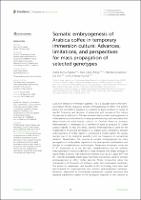| dc.description.abstract | Culture in temporary immersion systems (TIS) is a valuable tool for the semiautomation of high frequency somatic embryogenesis of coffee. This system allows the intermittent exposure of explants to liquid medium in cycles of specific frequency and duration of immersion with renewal of the culture atmosphere in each cycle. TIS have revolutionized somatic embryogenesis of coffee plants as an alternative for scaling up and reducing costs associated with labor-intensive solid media culture. In Central America, somatic embryogenesis is employed on a commercial scale to produce F1 Coffea arabica hybrids. In Asia and Africa, somatic embryogenesis is used for the multiplication of selected genotypes of C. arabica and C.canephora. Somatic embryogenesis of coffee plants is considered a model system for woody species due to its biological versatility and low frequency of somaclonal variation. Nevertheless, the success of somatic embryogenesis for mass propagation of coffee plants depends on the development, optimization, and transfer of complementary technologies. Temporary immersion using the RITA® bioreactor is, so far, the best complementary tool for somatic embryogenesis of Arabica coffee for a single recipient with simple changes in liquid media. Likewise, high volume bioreactors, such as 10-L glass BIT® and 10-L flexible disposable plastic bags, have been successfully used for somatic embryogenesis of other coffee species. These bioreactors allow the manipulation of thousands of embryos under semi-automated conditions. The protocols, advantages, and benefits of this technology have been well documented for organogenesis and somatic embryogenesis pathways. However, adaptation in commercial laboratories requires technical and logistical adjustments based on the biological response of the cultures as well as the costs of implementation and production. This review presents the historical and present background of TIS and its commercial application and, in particular, pertinent information regarding temporary immersion culture for C. arabica somatic embryogenesis. The main limitations of this technology, such as hyperhydricity, asynchrony, and developmental abnormalities, are examined, and a critical analysis of current knowledge regarding physiological, biochemical, and molecular aspects of the plant response to temporary immersion is offered. Further, perspectives are provided for understanding and solving the morpho-physiological problems associated with temporary immersion culture of coffee plants. | es_ES |


